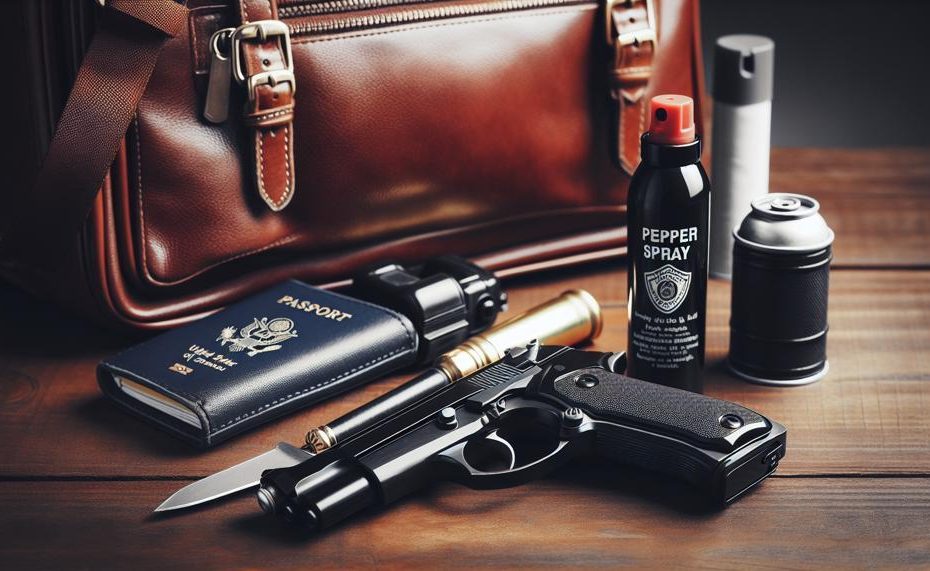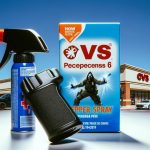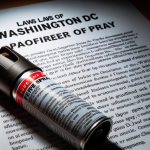Have you ever felt a twinge of fear while walking alone at night?
Do you worry about your safety in crowded public places?
Are you searching for a way to protect yourself without breaking any rules?
If these questions resonate with you, then this blog post is a must-read.
Today, we’re tackling the hot topic of carrying pepper spray on flights. It may seem like a small and inconspicuous item, but it can be a powerful tool for self-defense and peace of mind.
However, there are strict regulations and limitations when it comes to bringing it on board with you.
Here, we’ll delve into everything you need to know about pepper spray and its use in carry-on luggage.
From the do’s and don’ts to legalities and alternative options, we’ve got you covered.
So, fasten your seatbelts and prepare to learn how to fly safe.
Contents
Can you bring pepper spray on a plane?
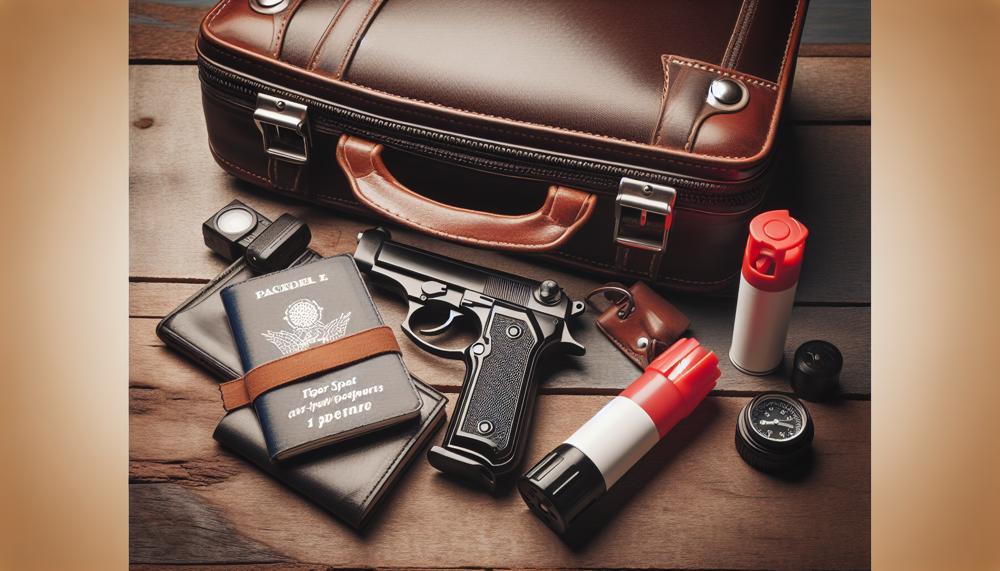
Yes, it is possible to bring pepper spray on a plane, but strict restrictions and guidelines must be followed to ensure the safety of all passengers. The FAA does not permit pepper spray in either checked or carry-on baggage because it is a hazardous material.
However, one 4 fl. oz. container of pepper spray can be brought in checked baggage as long as specific criteria are met.
| Guidelines for Bringing Pepper Spray on Planes | ||
| Restrictions | Checked Baggage | Carry-on Baggage |
| Largest Permissible Size | No larger than 4 fl. oz. (8 ml) | Not allowed |
| Maximum Tear Gas Concentration | Not exceeding 2% | Not allowed |
| Safety Mechanism Requirement | Must have a safety mechanism to prevent accidental discharge | Not applicable |
It’s essential to note that some airlines may have their own policies and not allow pepper spray on board at all. Therefore, it’s best to check with the airline beforehand to avoid any issues while traveling.
The Transportation Security Administration (TSA) also advises travelers to have their guidelines on hand when flying to prevent any conflicts or misunderstandings.
If you plan on bringing pepper spray on an international flight, it’s crucial to research the laws and regulations of the country you are visiting beforehand. Some countries may have strict restrictions or even prohibit pepper spray altogether, so it’s essential to be aware of these rules.
Additionally, any items attached to pepper spray, such as keychains or lighters, are not allowed through passenger security checkpoints. This includes pepper spray lighters, which are prohibited in both checked and carry-on luggage.
Lastly, it’s crucial to check the expiration date of your pepper spray before bringing it on a plane. Most pepper sprays have a shelf life of 2 to 5 years and may not be allowed on a plane if they have expired.
TSA-compliant pepper spray
TSA-compliant pepper spray, also known as “TSA-approved” pepper spray, is a type of self-defense weapon that is permitted on airplanes. However, to guarantee the safety of all passengers, there are specific requirements that must be met.
When used in accordance with the Transportation Security Administration’s (TSA) regulations, this specialized pepper spray is safe to transport in a carry-on bag.
To qualify as TSA-compliant, the pepper spray must adhere to the specific rules set by both the TSA and the Federal Aviation Administration (FAA). These regulations include:
- The pepper spray must be securely stored in a checked bag with a safety mechanism.
- The highest amount of tear gas (CS or CN) allowed is 2%.
- It cannot be carried as a carry-on item on any airline.
- The maximum size allowed is 4 fluid ounces, regardless of the amount of liquid inside.
To ensure compliance, it is essential to check for keywords such as “safety switch” when purchasing pepper spray. Some brands come equipped with built-in safety mechanisms, while others may require additional measures such as a case or sheath to prevent accidental discharge.
It’s worth noting that the limitation of 2% tear gas applies specifically to CS or CN, but not Oleoresin capsicum (OC). However, airlines may have conflicting policies when it comes to pepper spray, so it’s always best to have the TSA webpage on hand for reference.
When carrying pepper spray on a plane, it’s important to remember that it can pose a fire hazard when used in aerosol form. As such, it is recommended to pack it in a checked bag and declare it upon entry when traveling internationally.
Lastly, while pepper spray is legal to possess in most states, there may be restrictions on its use and possession in certain places, such as schools or during mail travel. Additionally, it’s crucial to check the legality of pepper spray in the country you’re visiting when traveling abroad.
TSA pepper spray rules
The TSA and FAA strictly regulate pepper spray, a self-defense weapon. As a classified weapon, it is not allowed in carry-on or checked bags. However, travelers are allowed to pack one container of pepper spray, which cannot exceed 4 fluid ounces, in their checked luggage. This applies to both domestic and international flights.
| Container Size | Permitted Location | Additional Regulations |
| Up to 4 fluid ounces | Checked baggage | – Must include a safety mechanism – Limited amount of tear gas |
It’s important to keep in mind that the TSA considers pepper spray a prohibited item and will confiscate it if found in a carry-on during security screening. This is due to the potential for serious harm and temporary blindness when sprayed on someone’s face.
In addition to TSA regulations, there may also be restrictions on the possession and use of pepper spray in certain areas.
Some states have specific laws regarding the strength of pepper spray and who can possess it. It’s important to research local laws before traveling with pepper spray.
Lastly, it’s crucial to be cautious of potential fire hazards when traveling with pepper spray. Pepper spray is flammable and should not be exposed to heat sources or open flames.
To avoid any accidents, ensure proper storage in checked luggage and inform airline personnel if traveling with it.
Why is pepper spray restricted on planes?
Pepper spray is not permitted in carry-on luggage on airplanes due to its classification as a weapon and potential safety hazard. It is heavily regulated and can only be packed in checked bags, not carried on. This restriction is in place to protect the well-being of passengers and crew members on the aircraft.
Also known as OC spray, pepper spray is a chemical compound derived from hot peppers that can cause severe discomfort to the eyes, nose, throat, and skin upon contact. It is commonly used for self-defense against attackers and has been proven effective in warding off potential threats.
However, when used in enclosed spaces such as an airplane cabin, pepper spray can have even more dangerous consequences. It can cause extreme irritation and temporary blindness for up to 30 minutes or longer. This could result in chaos and panic among passengers, ultimately jeopardizing the safety of everyone on board.
Furthermore, pepper spray is highly flammable when used in aerosol form. It has the potential to ignite easily and spread rapidly in the confined space of an airplane cabin, posing a significant fire hazard. This could have catastrophic impacts on passengers and crew members.
To prevent any potential danger, airlines strictly prohibit pepper spray in carry-on luggage. It must be packed in checked baggage, where it can be safely secured and monitored by airport security. Travelers should also research local laws at their destination, as some countries may have stricter regulations on carrying pepper spray.
Mace versus pepper spray
Mace and pepper spray are two common self-defense products, but they differ significantly in their composition and effectiveness. Despite both causing temporary discomfort and incapacitation, their ingredients and effects are distinct.
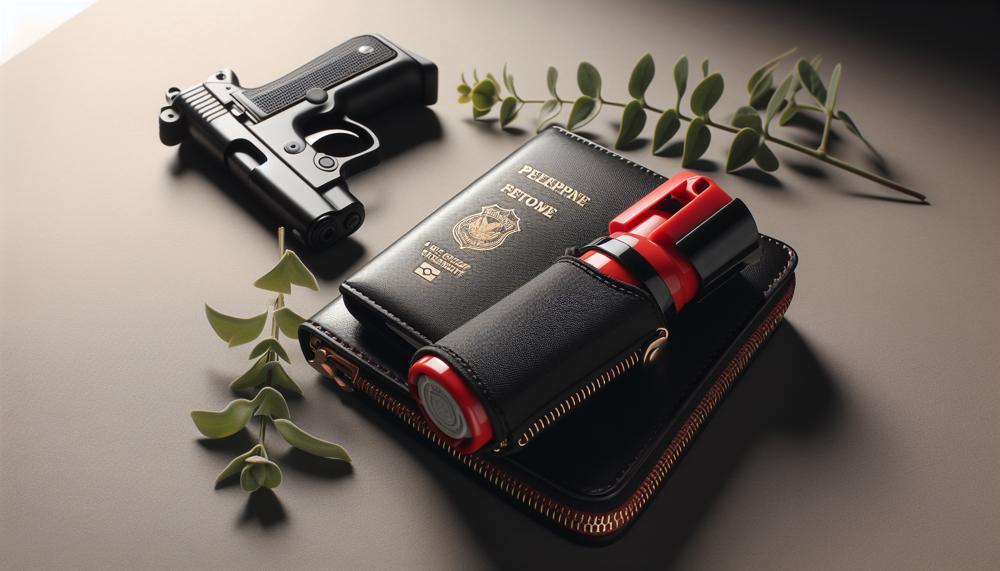
| Mace | Pepper Spray |
| Mace is a chemical spray that contains a volatile carrier base and % tear gas. This chemical irritates the eyes, nose, and throat of the target, causing them to cough and experience burning sensations, forcing their eyes to close. | Pepper spray, on the other hand, contains OC (oleoresin capiscum), a hot pepper extract in an oil carrier base. Upon contact with someone’s face, it causes swelling of the eyes, nose, and throat, resulting in extreme pain and temporary blindness. |
| Mace is less effective at deterring an attacker compared to pepper spray. Its effects are short-lived, lasting only for about 30 minutes or less. | On the contrary, pepper spray is highly effective in deterring an attacker and is the preferred choice for self-defense. Its effects can last up to an hour, providing the victim with ample time to escape or seek help. |
| Law enforcement agencies frequently use mace as a crowd control tool, and it is also available for civilian use. | While pepper spray is primarily used for self-defense purposes and is not recommended for law enforcement use due to its inflammatory effects. |
| Mace can cause respiratory distress in individuals with pre-existing respiratory conditions such as asthma or allergies. | Pepper spray can also cause severe allergic reactions in some individuals, especially those with known allergies to hot peppers. |
| Mace is prohibited on airplanes due to its classification as a weapon and potential safety hazard, and it must be packed in checked baggage. | Pepper spray is also not allowed on airplanes, but it can be carried in checked baggage as long as it meets size and packaging requirements. |
While both mace and pepper spray can serve as self-defense products, their composition, effectiveness, and recommended use vary significantly.
Pepper spray’s stronger effects and longer-lasting incapacitation make it the preferred choice for personal protection.
It is crucial to understand these differences to make an informed decision when selecting a self-defense tool.
Is pepper spray legal in every state?
No, pepper spray is not allowed in carry-on bags for air travel in every state. The Transportation Security Administration (TSA) considers it a prohibited item for carry-on luggage due to its classification as a hazardous material by the Federal Aviation Administration (FAA).
This means that you cannot bring it on the plane with you in your carry-on bag or on your person.
Pepper Spray as a Prohibited Item for Air Travel:
Pepper spray’s potential to cause harm to other passengers makes it a prohibited item for air travel.
It is important to note that even if you have a valid Concealed Carry Weapon (CCW) permit, you are still not allowed to bring pepper spray on a plane with you.
This is to ensure the safety and well-being of all passengers on board.
State Laws and International Laws for Pepper Spray:
In addition to federal regulations, it is also crucial to be familiar with state laws regarding pepper spray. While it is legal in most states, some have specific restrictions or limitations on the type and amount that can be carried.
It is essential to research the laws of the state you are traveling to before bringing pepper spray with you.
Moreover, if you are traveling internationally, it is imperative to research the laws of that country regarding pepper spray.
Some countries may consider it a weapon and prohibit its possession, while others may have specific regulations on the type and amount allowed.
It is always best to be informed and comply with local laws to avoid any legal issues during your travels.
Alternatives to Pepper Spray for Self-Defense:
As pepper spray is not allowed in carry-on bags for air travel, it is important to consider alternative options for self-defense.
One option is a personal alarm, which emits a loud sound when activated, potentially scaring off an attacker and alerting others nearby.
Another option is a tactical pen or keychain, which can be used as a weapon in emergency situations. These alternatives are not only effective, but also travel-friendly and allowed on planes.
Airline policies on pepper spray
Airline policies on pepper spray are strict and vary from airline to airline. Most airlines prohibit carrying pepper spray as a carry-on item, but some may allow it in checked baggage if it meets certain requirements.
These requirements include a container size no larger than 4 fluid ounces, being equipped with a safety mechanism to prevent accidental discharge, and a tear gas percentage not exceeding 2% by mass. Additionally, the container must have a cap or cover over the trigger.
However, it’s important to note that conflicting policies may exist among different airlines, so it’s best to have the TSA webpage readily available for reference if needed.
When traveling internationally, it’s crucial to research and comply with the regulations of the destination country regarding pepper spray. While it may be legal in some countries, it may be considered a prohibited item in others. It’s also worth noting that pepper spray cannot be attached to keychains when going through security.
Bear spray is specifically designed to deter bears and is not allowed on planes, but it may be available for rent at national parks in bear country. Travelers should keep in mind that bear spray is not meant for human use, and alternative options should be considered for self-defense when traveling.
Moreover, pepper spray has an expiration date of 2 to 5 years; therefore, travelers should always check the expiration date before bringing it on a trip. Lastly, pepper spray lighters are not allowed as carry-on items on planes.
To ensure a hassle-free travel experience, it is important to thoroughly research and comply with the policies of both the TSA and the specific airline being used when considering bringing pepper spray for self defense. State and international laws regarding its possession should also be taken into account.
Bear spray
Bear spray, also known as pepper spray, is a type of self-defense weapon that is derived from a chili plant. It contains a chemical compound called capsaicin, which can cause temporary blindness and intense pain when sprayed on someone’s face. This makes it an effective deterrent for aggressive bears and other wildlife.
Due to its potential danger, bear spray is not allowed in carry-on baggage or on your person while flying. This is because it is classified as a hazardous material and can only be transported in checked baggage. Most bear sprayers are above the 3.4-ounce size limit for carry-on items and, therefore, are prohibited in both carry-on and checked baggage.
Airline policies on bear spray may vary, but most prohibit it as a carry-on item due to safety concerns in the confined environment of an aircraft. It is important for travelers to research destination and international regulations as well, as some countries may have stricter rules on carrying pepper spray.
Additionally, attaching bear spray to keychains or carrying it on a keychain is not recommended, as this can lead to accidental discharge and potential harm. Before traveling, be sure to check the expiration date of your bear spray, as expired sprays may not be as effective.
If you are considering alternative self-defense options, a personal alarm or whistle may be a better choice for carry-on baggage. These items are typically allowed and can still serve as a deterrent against potential threats.
Bear spray lighters, which combine both pepper spray and a lighter, are also prohibited on planes due to the compressed gas aerosol classification.
Rules for international travel
When embarking on an international journey, it is vital to stay informed about the rules and guidelines set by authoritative organizations such as the International Air Transport Association (IATA) and the Transportation Security Administration (TSA) concerning the transportation of pepper spray. While it is permissible to pack pepper spray in checked baggage for domestic flights within the United States, it is prohibited in carry-on luggage.
However, regulations may differ for various countries, so it is imperative to conduct thorough research on the laws and regulations of your planned destination before including pepper spray in your luggage.
Additionally, airlines have specific restrictions on liquid or gel substances, and most do not permit aerosol sprays in either checked or carry-on baggage. Some countries may also require special permits for the possession of pepper spray, making it crucial to investigate and comply with their regulations.
Non-compliance with these rules could lead to confiscation of the item or legal consequences.
As a seasoned traveler, I have encountered my fair share of challenges when navigating international travel regulations. On one particular trip to Japan, I was unaware that pepper spray was prohibited in both checked and carry-on luggage.
Despite having researched the laws and regulations beforehand, I overlooked this crucial detail and had to surrender my pepper spray at security. This experience taught me the importance of double-checking all rules and regulations when traveling internationally.
It is essential to note that different countries have varying laws and regulations regarding pepper spray. For example, while it is legal to possess and transport pepper spray in some European countries, others strictly prohibit its use. Therefore, it is crucial to research and comply with the specific regulations of each country you plan to visit.
Furthermore, even if a country allows the possession of pepper spray, airlines may have different rules. For instance, some airlines allow small containers of pepper spray in checked baggage but not in carry-on luggage. It is always wise to check with your airline before packing pepper spray to avoid any complications during security checks.
Conclusion
In conclusion, the question of whether or not pepper spray is allowed in carry-on luggage is a crucial one to consider when traveling.
While it may provide a sense of protection and peace of mind, it must be packed appropriately and follow strict guidelines. It’s vital to do thorough research on airline policies and have the TSA regulations handy before embarking on your journey.
Moreover, it’s essential to be aware of state and international laws regarding pepper spray and explore alternative options for self-defense while flying. Safety should always be a top priority, and staying informed about regulations and alternatives can ensure a smooth and secure trip.
So, next time you find yourself walking alone at night or in a crowded public place, remember that although pepper spray may not be allowed in your carry-on, there are still ways to protect yourself without violating any rules.
